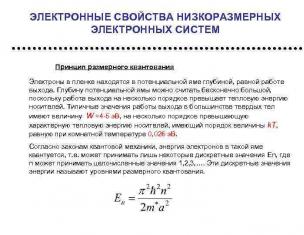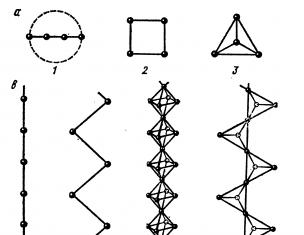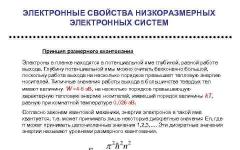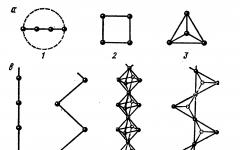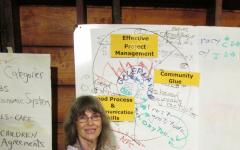1. Catch the ball
1 point - the child did not begin to cooperate even after training and behaves inappropriately (throws the ball, takes it in his mouth, etc.).
2 points - the child has learned and began to cooperate, tries to roll the ball and catch the ball, but this is not always possible in practice.
3 points - the child independently began to cooperate, but it is not always possible to catch the ball due to motor difficulties; after training, the result is positive.
4 points - the child immediately began to cooperate with the adult, successfully catches and rolls the ball.
2. hide the balls
1 point - the child did not understand the task, does not strive for the goal; I did not understand the task after the training.
2 points - the child did not understand the task; after learning, he strives to achieve the goal, but he does not have correlative actions; indifferent to the final result; does not complete the task on its own.
3 points - the child immediately understood the task, but difficulties arose when performing correlative actions (he could not correlate the corners of the lid with the box); interested in the result of their activities; performs the task after training.
4 points - the child immediately understood the task; completed the task and at the same time used correlative actions; interested in the end result.
3. Disassembly and folding nesting dolls
1 point - the child did not learn how to fold the matryoshka; after training, he acts inadequately on his own: he takes it in his mouth, throws it, knocks it, holds it in his hand, etc.
2 points - the child performs the task in conditions of imitation of the actions of an adult, does not complete the task on his own.
3 points - the child accepted and understood the task, but performs it after the help of an adult (pointing gesture or verbal instruction); understands that the final result is achieved; after training, he folds the nesting doll on his own.
4 points - the child immediately understood and accepted the task; performs it independently; the presence of correlative actions is noted; interested in the end result.
4. Dismantling and folding the pyramid
1 point - the child acts inadequately: even after training, he tries to put the rings on the rod, closed with a cap, scatters the rings, clamps them in his hand, etc.
2 points - the child accepted the task; when assembling, does not take into account the dimensions of the rings. After training, strings all the rings, but the size of the rings still does not take into account; dominant hand not defined; there is no coordination of actions of both hands; indifferent to the end result of his actions.
3 points - the child immediately accepts the task, understands it, but strings the rings on the rod without taking into account their size; after training, the task performs without error; the leading hand is determined, but the coordination of the actions of the hands is not expressed; adequately evaluates the result.
4 points - the child immediately independently disassembles and assembles the pyramid, taking into account the size of the rings; the leading hand is determined; there is a clear coordination of the actions of both hands; interested in the end result.
5. Paired pictures
1 point - after training, the child continues to act inappropriately: turns pictures over, does not fix his eyes on the picture, tries to take a picture from an adult, etc.
2 points - the child understands the task, but cannot complete it immediately; in the process of learning compares paired pictures; he is indifferent to the assessment of his activities, he does not perform the task on his own.
3 points - the child immediately understands the condition of the task; makes one mistake, after training acts confidently; understands that the end result is achieved.
4 points - the child immediately understands the task and confidently compares paired pictures; interested in the end result.
6. colored cubes
1 point - the child does not distinguish colors even after training.
2 points - the child compares colors, but does not highlight the color according to the word even after learning; indifferent to the end result.
3 points - the child compares and highlights the color by the word; shows interest in the outcome.
4 points - the child compares colors, highlights them by word, names the main colors; interested in the end result.
7. Split pictures
1 point - the child acts inadequately after training: he does not try to correlate parts of the split picture with each other.
2 points - the child folds the split picture with the help of an adult; he is indifferent to the final result, he cannot put the picture together on his own.
3 points - the child immediately understands the task, but puts the picture together with the help of an adult; after training, he folds the picture on his own; understands that the end result is positive.
4 points - the child understands the task; independently folds a split picture; interested in the end result.
8. Construction from sticks
1 point - the child after training continues to act inappropriately: throws sticks, puts them next to him, waves them; indifferent to the result.
2 points - the child, after training, tries to build a figure, but compliance with the model is not achieved; irrelevant to the end result.
3 points - the child correctly understands the task, but builds a "hammer" only after imitating the actions of an adult; interested in the end result.
4 points - the child correctly performs the proposed task according to the model; interested in the end result.
9. Get the cart
1 point - the child does not understand the task; does not seek to achieve the goal.
2 points - the child tries to reach the target with his hand; after several unsuccessful attempts, he refuses to complete the task.
3 points - the child tries to get the cart by one end of the ribbon; after two or three attempts achieves the result; understands the end result of their actions.
4 points - the child immediately finds the correct solution and completes the task; interested in the end result.
10. draw
1 point - the child does not use a pencil to draw on paper; behaves inappropriately to the task; does not follow verbal instructions.
2 points - the child has a desire to depict something (scribbling); indifferent to the final image; the leading hand is not selected; there is no coordination of actions of both hands.
3 points - the child understands the instructions; tries to draw a path, depicting it with multiple broken lines without a specific direction; understands the end result of their actions; the leading hand is determined, but there is no coordination of actions of both hands.
4 points - the child performs the task according to the verbal instruction; interested in the final result (in most cases This straight continuous line); the leading hand is clearly defined, the coordination of the actions of both hands is observed.
According to the sum of points, the examined child can be assigned to one of four groups.
First group(10-12 points) - these are children who are not guided by the instructions in their actions, do not understand the purpose of the task, and therefore do not strive to complete it. They are not ready to cooperate with an adult; not understanding the purpose of the task, they act inadequately. Moreover, this group of children is not ready to act adequately even under conditions of imitation.
The indicators of the children of this group testify to a deep trouble in their intellectual development. These children need to form an emotional contact with an adult. Emotional communication between an adult and a child arises on the basis of joint actions, which should be accompanied by a friendly smile and an affectionate voice. An adult should gently touch the child, stroke him, take his hand, etc.
These children must be taught to understand an elementary instruction, to perform an action in accordance with a verbal instruction, consisting of a single word denoting an action. At the same time, it is necessary to teach children to understand the purpose of the action; to develop in them the actions of grasping with two hands, with one hand; develop attention, gaze fixation, eye tracking of a moving object.
In addition, these children should be physical exercise, focused on the development of all basic movements, as well as general developmental exercises aimed at strengthening the muscles of the back, coordination of movements, development of balance.
When teaching children of this group, the main methods are joint actions of a child with an adult, imitation of the actions of an adult.
To the second group(13–23 points) include children who cannot complete the task on their own. They hardly come into contact with adults, act without taking into account the properties of objects. In the nature of their actions, there is a desire to achieve a certain result, therefore, chaotic actions are characteristic of them, and in the future - refusal to complete the task.
In a learning setting, when an adult asks to perform an imitation task, many of them cope. However, after training, the children of this group cannot independently complete the task, which indicates that the principle of action remained unaware of them. At the same time, they are indifferent to the result of their activities.
In this group of children, it is necessary to form ways of assimilation of social experience. The first condition for this is the formation of cooperation between the child and the adult. The basis of such cooperation is, on the one hand, the emotional contact of the adult with the child, and on the other hand, the correct definition of the method of setting educational and upbringing tasks for the child. It is important to develop in children the ability to imitate the actions of an adult, the ability to understand and use gestural instructions and pointing gestures, the ability to work according to the model and according to verbal instructions.
A special place in the correctional work with these children should be occupied by physical education. It is aimed at the timely development of motor skills, abilities and physical qualities, at the development of interest in various types of motor activity available to the child.
At the same time, attention should be paid to the improvement of manual motor skills, the development of the leading hand, the coordination of the actions of both hands, as well as the development of small movements of the hands.
The central task of working with this group of children is the formation of guidelines for face-to-face cognitive activity: the development of practical orientation to the properties and qualities of objects, the formation of targeted trials, practical fitting, and then visual correlation. The main thing at the same time is to remember that the development of perception comes from the ability to distinguish objects, their properties, attitudes towards their perception based on the image, and then to the fixation of the image in the word, that is, to the appearance of an image-representation.
In the future, corrective work on the development of orienting-cognitive activity should be aimed at forming the relationship between the main components of mental activity: action, word and image.
One of the main areas of work with these children is the development of speech. It is carried out in the course of the entire life of the child and in special classes where specific tasks are solved: the development of communication, cognitive and regulatory functions.
In addition, the main correctional task in working with these children is the formation gaming activity and prerequisites for productive activities (drawing, design).
Children need to form an interest in didactic and plot toys, play actions with these toys, the ability to play next to their peers, and later together.
Given all of the above, it must be remembered that all these children need to form the correct behavior, taking into account a certain situation, as well as some personality traits of each child, where the main attention is paid to such qualities as mutual assistance and responsiveness. This possibility is ensured by the creation of a positive microclimate, both in preschool and in the child's family.
third group(24–33 points) are children who are interested in cooperating with adults. They immediately accept tasks, understand the conditions of these tasks and strive to fulfill them. However, on their own in many cases they cannot find an adequate way to perform and often turn to an adult for help. After being shown how to complete the task, many of them are able to complete the task on their own, showing great interest in the result of their activities.
In children of this group, it is necessary to clarify the primary violations. Regardless of the primary violation, all children need to form an active interest in the properties and qualities of objects, develop perceptual actions (trials, trying on). At the same time, it is necessary to develop productive activities: modeling, appliqué, drawing, designing.
An important direction in corrective work with these children is the formation of a holistic view of the surrounding reality, of a person and of interactions between people, familiarization with various types of activities.
In all cases, corrective work is carried out with these children on the development of speech. Depending on the primary violation, a specific system is created for including the child's speech in the process of sensory cognition of the surrounding reality.
fourth group(34–40 points) are children who accept all tasks with interest, perform them independently, acting at the level of practical orientation, and in some cases at the level of visual orientation. At the same time, they are very interested in the result of their activities. These children usually reach good level mental development.
Thus, the proposed psychological and pedagogical examination makes it possible to identify in children early age mental retardation and helps psychologists and teachers-defectologists to outline ways corrective work with each of the examined children, taking into account their individual structure of the disorder.
Stanford Binet test for children from 3 years old
Among the numerous translations and adaptations of the Binet tests, the most viable was the Stanford Binet test (restandardized in 1972). It is designed to measure IQ from 3 years to adulthood. However, according to Western psychologists, the Stanford-Binet scale is not suitable for testing adults, and primarily those whose intellectual development is within and above the norm.
Based on our own experience, we can say that this scale is most applicable to examining children from 3 to 5 years old, so only subtests for these ages are given here, and the examination of children from 4 years of age and older is best done using Wechsler tests. WPPSI And WISC.
The battery of tests for each age level consists of six tests.
The tests within each age level are approximately the same in terms of difficulty and are arranged without taking into account the complexity of the tasks. For each age level, there is a reserve test of the same degree of difficulty, which is used as necessary instead of any of the tests of this level, for example, when one of the main tests cannot be used because it does not suit this individual or something prevents him from presenting it.
Four tests from each level, according to their validity and representativeness, are selected for the reduced scale, which is used when time does not allow the full scale to be presented. Comparisons IQ, received on the full and reduced scales on different groups of subjects conducted by Western psychologists, found a fairly complete agreement between them, the correlation is about as high as the full scale reliability coefficient. Average value IQ, however, it decreases slightly on the short scale. This discrepancy also manifests itself when comparing the number of subjects who showed higher results in each version of the scale. Over 50% of them receive lower values in the short version compared to the full version IQ and only 30% have a value IQ higher.
Like most intelligence tests, the Stanford-Binet test requires well-trained experimenters, since the presentation and processing of many tests is quite complex. Therefore, a clear test is impossible without sufficient familiarity and experience with the scale. Indecision and ineptitude can have a detrimental effect on mutual understanding with the child. Minor changes in verbal formulations can change the difficulty of tasks. The test also complicates the need to process it immediately after presentation, since the subsequent test depends on how the child completed the tasks of the previous levels.
Many clinicians refer to the Stanford-Binet test not only as a standardized test, but also as a diagnostic interview. The Stanford-Binet test allows you to observe the methods of intellectual work of the subject, his approach to the problem, and other qualitative aspects of the performance of tasks. The experimenter can also judge some personality traits such as activity level, self-confidence, perseverance, ability to focus. Of course, any qualitative observations during the Stanford-Binet test need to be recorded as observations, but not interpreted in the same way as objective test scores. The value of qualitative observations depends on the skill, experience and psychological intuition of the psychologist.
In the Stanford-Binet test, no subject is tested for completing all tasks. The individual is presented with only those tasks that correspond to his intellectual level. It usually takes 30-40 minutes to test young children.
If the examined child copes with all the proposed tasks for children of three years of age, then this level of development is called the basic age.
Testing continues in ascending order (for four years, five years) until, at some level, the subject begins to fail in all tests. This level is called the ceiling age. Upon reaching this level, testing ends.
Jobs are processed on an all-or-nothing basis. The instructions for each test set the minimum execution level from which the test is considered to be completed. Certain tests are given at different age levels, but the criteria for their performance for each level are different. Such a test is presented only once, and its performance is determined by the age level to which the child is assigned. Tasks solved or not solved by the subjects give a certain spread to neighboring age levels. It is not the case that subjects pass all tests of their own or lower mental age and fail all tests above their level. In addition, successfully solved tests are distributed over several levels from the basic to the ceiling age of the subject. The mental age of an individual on the Stanford-Binet scales is determined by taking the base age and adding two additional months to it for each correctly solved test that is above this level.
For example, a child of 3 years and 2 months is examined (38 months is a calendar age). The child coped with all tasks for three years; so his base age is 36 months. And then he coped with two tasks for the age of four. Therefore, four more months are added to it (two months for each task). Since he did not cope with any task for children of five years old, his mental age is 40 months. IQ is calculated by the formula:
i.e. (40:34) × 100 = 110.
For age 3 years (6 tests, one every 2 months)
1. Specify: nose, eyes, mouth, hair (normal - 3 answers out of 4).
2. Name: key, cup, penknife, watch, pencil (3 out of 5).
3. Name three objects in each picture (1 of 3; Figures 1–3):
a) "Mother and daughter";
b) "On the river";
c) At the post office.
4. Name your gender ("Tell me, are you a boy or a girl?").


6. Repeat the phrase in 6-7 syllables (1 of 3):
a) "We have a kitten";
b) "Petya gave me a toy";
Additional test. Repeat 3 rows of numbers (1 of 3): 6‑4‑1; 3‑5‑2; 8‑3‑7.
Additional tests are offered only as an exception in cases where for some reason one or another main test cannot be used. Replacing an incorrectly solved main test with an additional one is not allowed.
For age 4 (6 tests, one every 2 months)
1. Comparison of lines. There are 3 options (3 out of 3): Which line is longer and which is shorter?
___________________________________________________________
_________________________________________
2. Shape difference: circle_______ square_________ triangle_________

4. Draw a square (1 of 3): 1 2 3.
5. Questions of the first degree of difficulty "What should be done?" (2 of 3):
a) When do you want to sleep ____________________________;
b) When you are cold ____________________________;
c) When you want to eat ____________________________.
6. Repeat 4 digits (1 of 3): 4‑7‑3‑9; 2‑8‑5‑4; 7‑2‑6‑1.
Additional test. Repeat the phrase in 12-13 syllables (1 of 3 without mistakes or 2 times with one mistake in each phrase):
a) His name is Maxim. He goes to school";
b) "Sasha heard the whistle and saw the train";
c) "There were a lot of mushrooms and berries in the forest in summer."
For age 5 years (6 tests, one every 2 months)
1. Comparison of weights (2 of 3): 3‑15 g _______ 15‑3 g _______ 3‑15 g _________.
2. Name 4 colors on the cubes (no mistakes): red ________ yellow _______ blue _________ green _______.
3. Aesthetic comparison. "Which people do you like best in each pair?" (no mistakes):
Top pair ________ Middle pair ___________ Bottom pair _______.

4. What are the following items used for (4 out of 6)?
Chair______________? Doll______________?
Automobile______________? Pencil______________?
Fork______________? Table______________?
5. Folding a rectangle of two triangles (2 out of 3; 1 minute for each execution):

6. "Remember and complete the three orders" (no mistakes): Put the key on the table.
Close the door ______________. Give a box
Additional test. State your age.
At the beginning of the 20th century, in the system of special schools for children with mental retardation and mental retardation, a diagnostic system was needed to separate normal children.
Simon and Binet - did a series of experiments on the study of thinking, memory, perception in children from 3 years old.
In 1905 he created a system intelligence tests, then the tasks improved, and in 1908 the second edition of the tests came out Binet-Simon, in 1911 year the last edition was published.
The most significant changes took place in 1908. The range of subjects by age was expanded (from 3 to 13 years old), the number of tasks was increased, the concept "mental age". Intellectual development was assessed with its help.
These tests are individual intelligence tests(only with one child).
Each age group has its own tasks.
Of all the tasks developed, the test system included those that were completed by 80-90% of children of this age.
Children under 6 years old - 4 tasks, older - 6 tasks each.
3 years - show your nose, ear, perform a simple task (give the key), the ability to repeat the word.
6 years - distinction right, left; task of several links, repeat the phrase.
8 years - repeat all the months of the year, retelling a simple text.
13 years - the ability to operate with abstract concepts (the difference between happiness and pleasure).
Diagnosis by Binet-Simon tests.
The presentation of all tasks corresponds to the chronological age. If he fulfilled his own, then they gave tasks of an older age.
Determine the maximum age base mental age(when all tasks are completed)
mental months were charged for those that were solved for the next age.
If the mental age is below the chronological age, then it was considered that the child was mentally retarded or mentally retarded. Or vice versa, then it was believed that the child was gifted to some extent.
Binet saw the disadvantage that his tasks were not solved by children who developed in an unfavorable environment. They could not know the names of some items.
The attention of a psychologist is necessary: replace an unfamiliar word, use the method of observation.
Generally this technique very effective, has been useful in the department of children who are unable to study in a regular school.
Gained popularity all over the world. Translation and adaptation of this methodology at Stanford University.
Stanford-Binet test (American method)
1. For the first time, they began to use IQ - intelligence quotient.
2. Concept introduced "statistical norm".
Instead of mental age, Americans began to use the concept of IQ, since mental age had a significant drawback (Stern pointed out in 1912): the same difference between the mental age of two people at different age levels had unequal significance. For example, at 3 and 4 years old, at 13 and 14 years old.
Relative indicator: mental age divided by chronological age and multiplied by 100:
IQ = (mental age: chronological age) x 100
1916 - the first edition of Stanford-Binet.
The statistical norm is a criterion used in psychodiagnostic methods to compare individual indicators and evaluate them.
In 1937 - the second edition Stanford Binet.
Age from 2 to 18 years, is a scale of 17 tests. One test each from 2 to 14 years old and 4 more tests for middle adult age (16-18 years old).
The technique is very high quality, it is still used and is considered a model of an intellectual test..
According to the Stanford-Binet test, all new tests are validated.
The Binet-Simon and Stanford-Binet tests are individual.
Then they began to appear group intelligence tests. This is due to the limited use of individual tests.
During the First World War, it was necessary to evaluate the intellectual development of recruits for their distribution among various branches of the military and institutions.
Arthur Otis- developed the first system of group intelligence tests - army. First published in 1917-1919.
Two forms: form Alpha - for those who know English (tasks, words); form Beta - for illiterates and foreigners (graphic images).
Army tests exist even now for the purpose of professional selection, updated.
Group tests- mass testing tools (dramatic reduction of time). We simplified the instructions, the procedure for conducting and processing the results.
Not psychologists were involved in testing, but specially trained people.
They are used in the education system, industry and the army.
Limitation of intellectual testing - it is impossible to predict the success of performing narrow types of activities.
It is impossible to select a narrow focus, it is necessary to evaluate other psychological features as well.
There was a direction diagnostics special abilities . The impetus was the powerful development of professional advice.
Tests of special abilities - musical, artistic.
The theoretical basis was factor analysis- highlighting the general, which was required in narrowly focused activities.
Especially developed psychotechnics- the use of psychology data in industry and economics.
The impetus for its development was the system of labor intensification (Taylor).
We need accurate knowledge about the psychological characteristics of workers.
Munstenberg proposed 2 methods for testing special abilities:
analytical direction- methods for diagnosing each mental function using separate techniques.
synthetic modeling- the most important moments professional labor, the most significant was modeled.
Separate tests of special abilities were combined and batteries of special abilities tests were created for a limited number of professional activities.
Batteries are used to select people for relevant professional activities.
An individual profile of the candidate is drawn, which correlates with the normative profile.
Achievement tests (learning success). Special group. Instead of teacher assessments, it is assessed how successfully the program is learned.
Replacement of oral examinations with written ones in 1845.
They are now used to assess student achievement, instead of regular exams.
Stanford Achievement Test(since 1923) - a combined test used in schools to assess the level of learning in various subjects (comprehension of oral speech, written text).
Psychodiagnostics Luchinin Alexey Sergeevich
4. Binet-Simon scale. The concept of "mental age". Stanford-Binet scale. The concept of "intellectual quotient" (IQ). Works by V. Stern
The first scale (a series of tests) Binet-Simon appeared in 1905. Binet proceeded from the idea that the development of intelligence occurs independently of learning, as a result of biological maturation.
A. Binet scale in editions (1908 and 1911) was translated into German and English languages, differed in that it expanded the age range of children - up to 13 years old, increased the number of tasks and introduced the concept of mental age.
The tasks in the Binet scales were grouped by age (from 3 to 13 years). Children under 6 years old were offered four tasks each, and children over 6 years old were offered six tasks. Tasks were selected by examining a large group of children (300 people).
The indicator of intelligence in the Binet scales was mental age, which was determined by the success of test items.
The second edition of the Binet scale served as the basis for the verification and standardization work carried out at Stanford University (USA) by a team of employees led by L. M. Termena. This option was proposed in 1916, had many major changes compared to the main one and was called the Stanford-Binet scale. There were two main differences from Binet's tests: the introduction of an intelligence quotient (IQ) as an indicator for the test, which is determined by the relationship between mental and chronological age, and the use of a test evaluation criterion, for which the concept of a statistical norm was introduced.
IQ score was offered V. Stern, who considered a significant drawback of the indicator of mental age that the same difference between mental and chronological age for different age levels has a different value. Stern proposed to determine the quotient obtained by dividing mental age by chronological age. This figure, multiplied by 100, he called the coefficient of intelligence. So you can classify normal children according to the degree mental development.
Another innovation of Stanford psychologists was the use of the concept of "statistical norm". The norm became the criterion by which it was possible to compare individual test indicators and thereby evaluate them, give them a psychological interpretation.
The Stanford-Binet scale was designed for children aged 2.5 to 18 years. It consisted of tasks of varying difficulty, grouped according to age criteria.
From the book Psychodiagnostics author Luchinin Alexey Sergeevich3. Behaviorism as theoretical background testing. Behavior as a set of reactions of the organism to stimuli. The works of J. M. Cattell, A. Binet Test methods are usually associated with behaviorism. Behaviorism introduced into psychology as the leading category of behavior.
From the book Psychodiagnostics author Luchinin Alexey Sergeevich7. Tests of achievements. Questionnaires. Introspectionism as the theoretical basis of the method. The works of F. Galton, A. Binet, R. Woodworth Achievement tests, unlike intelligence tests, reflect the influence special programs training on the effectiveness of solving test tasks. In America
From the book Psychology of Help [Altruism, Egoism, Empathy] author Ilyin Evgeny PavlovichScale of dispositional egoism Author: K. Muzdybaev (2000).Instruction. You are offered a number of judgments. Rate your attitude towards them on a seven-point scale: 7 - completely agree, 4 - something in between is true, 1 - completely disagree. In judgments 2, 3 and 6, the scale is reversed (complete agreement
From the book Treatment of Alcoholism author Claude SteinerThe Emotional Awareness Scale Now let me introduce the Emotional Literacy Scale to illustrate this concept. On fig. 2 shows a hypothetical continuum between two extremes that do not occur in real life states; 0 to 100%
the author Prusova N V1. The concept of work. Pros and cons of work. The concept of unemployment Work is a materially rewarded human activity aimed at creating certain benefits. The presence or absence of work affects the status characteristics of the individual, the possibility of realizing
From the book Labor Psychology the author Prusova N V29. The concept of labor mobility. Types of mobility. The concept of labor physiology. Working environment factors Labor mobility is understood as a change in professional status and role, which reflects the dynamics professional growth. Elements of labor
From the book Labor Psychology: Lecture Notes the author Prusova N V1. The concept of work Work is a financially rewarded human activity aimed at creating certain benefits. Work is the labor of a person, and labor is understood as a conscious, purposeful activity, the application by people of mental or physical
From the book 10 stupidest mistakes people make author Freeman ArthurTen-point scale How would you rate your current problem on a scale of one to ten? If you feel depressed, sad, if your nerves have flared up, or you are tormented by depression, or if for some other reason you are unsettled in answering a question, you,
From the book Motivation and Motives author Ilyin Evgeny PavlovichMethodology "Scale of Conscientiousness" The following scale is taken from the "Psychodiagnostic Test", developed by V. M. Melnikov and L. T. Yampolsky on the basis of foreign methods (MMPI and R. Cattell's 16-factor questionnaire). The "Scale of Conscientiousness" is intended for measurement
From the book Addiction. family disease author Moskalenko Valentina DmitrievnaCodependency scale 1. I find it difficult to make decisions.2. It's hard for me to say no.3. I find it hard to accept compliments as something deserved.4. Sometimes I almost miss if there are no issues to focus on.5. I usually don't do for others what they can do for themselves.
author Sternberg RobertAlfred Binet: Identifying Learning Ability In 1904, the Minister of Public Education in Paris created a commission to work out methods to distinguish truly mentally "defective" children from those who did not do well in school for other reasons. What was the task before
From the book The Intelligence of Success author Sternberg RobertTests based on Binet's theory What questions are included in tests to determine IQ? Many of us have heard of such tests, have been tested at one time or two, but hardly remember the specific content of the questions. In fact, too many people like to speculate about
From the book I Am a Man author Sukhov Dmitry Mikhailovich From the book Age of Psychology: Names and Fates author Stepanov Sergey Sergeevich author Schegolev Ilya Vladimirovich From the book Graphology of the XXI century author Schegolev Ilya VladimirovichThe Stanford-Binet intelligence scale (the famous IQ test) is widely used in Europe and the USA. It is used to assess the preparation of a child for school, including with a profile bias, and the readiness of an applicant to enter a university. The level of development of intellectual abilities in quantitative terms is most often measured by the Stanford-Binet method.
The Stanford-Binet test is used in the following cases:
- Evaluation of the abilities of normally developing subjects and with special needs.
- Diagnosis of autism.
- Recognition of children gifted with abilities.
- Diagnostics of professional suitability.
- Research of the level of creativity.
- Drawing up an IQ-independent portrait of the child's personality: indicators of activity, concentration, effort, confidence.
Brief historical background
The primary test was developed in 1905 by Alfred Binet and Théodore Simon on the orders of the French Ministry of Education in order to weed out underdeveloped children before entering school. The Binet-Simon test revealed the correspondence of intellectual abilities to the physical development of the child, and the number of tasks solved determined his mental age.
In 1916, the test was modified by Lewis Terman from Stanford University (USA). That is why the test became known as the "Stanford-Binet" and is widely used to this day. At the center of the methodology is the IQ coefficient (Intelligence quotient) - a quantitative assessment of intelligence in a numerical indicator. In the fifth version of the test, created in 2003, the scoring method and their interpretation have been changed, and all processes have been fully automated. Can be used for children from 2 years old.
Structure and application of the test
The 2003 edition of the Stanford-Binet test includes five parts:
- Definition of mobile (free) intelligence dependent on biological factors.
- Verbal research (knowledge test).
- Computing tasks (quantitative intelligence).
- Visual perception and spatial thinking.
- The study of working short-term memory.
These 5 factors of intellectual ability are taken from the Cattell-Horn-Carroll theory.
Time limits - 15-75 minutes (depending on the age and intellectual abilities of the subject).
Interpretation of the results: IQ coefficient 70-79 - borderline, 80-89 - below average, 90-109 - average, 110-119 - above average, above 130 - an indicator of a gifted person.
The Stanford-Binet test cannot be used in diagnosis. psychological disorders and predicting the development of intellectual abilities, since it does not reveal the nature of the data, but only states their presence.
lat. scala - stairs] - an intelligence test designed to measure the level of mental development. The first option S.-B. y. R. sh. was developed by L. M. Theremin in 1916 and was a modification of the Binet-Simon scale of mental development. In the course of development, the basic methodology was introduced a large number of changes. Compared to the Binet scale, more than a third of new tasks were added, a number of old ones were either redone, or discarded or redirected to others. age groups. In fact, the first edition of S.-B. y. R. sh. was a new test. In the future, the test was repeatedly radically improved. S.-B. y. R. sh. includes tasks aimed at exploring a wide range of abilities - from simple manipulation to abstract reasoning. At early age levels, tests require mainly hand-eye coordination, perceptual differences, the ability to understand instructions (in tasks such as folding cubes, stringing beads, matching geometric shapes), as well as the ability to recognize objects presented in the form of toy models or images on cards. At the highest age levels, tests that use the verbal content of tasks are most represented. Among them are a vocabulary test (explaining the meaning of words), analogies, completion of sentences, definition of abstract concepts, interpretation of proverbs. Some tests are aimed at characterizing the degree of fluency and fluency of speech (quick naming of unrelated words, selection of rhymes, construction of sentences with given words). Among the tasks of the battery, tests of general awareness, knowledge of norms are widely represented. public life, rules of conduct (answers to questions, interpretation of situations, detection of inconsistencies in plot pictures or stories). The scale includes a number of tests of memory, spatial orientation (visual reproduction of figures, labyrinths, folding and cutting paper objects, etc.). At higher age levels, the degree of assimilation of certain skills acquired at school (the ability to read, knowledge of arithmetic) is analyzed. When examining with the help of a number of tests, the technique allows for the possibility of obtaining broad qualitative information about the methods of work of the subject, how he solves problems. Great opportunities are also provided for monitoring personal qualities: the level of activity and motivation, confidence, perseverance, concentration, etc. The complex procedure for conducting the survey and interpreting the results, the need for strict adherence to standards require high qualification and preliminary training of the experimenter. According to the application of S.-B. y. R. sh. vast experience has been accumulated, including factual data and their interpretation. In terms of the breadth of use, this technique occupies one of the leading places among intelligence tests in foreign psychodiagnostics. The duration of use and the breadth of distribution made the frame of reference for S.-B. y. R. sh. standard for other psychometric tests. The distribution of the results of IQ-indicators of the Stanford-Binet scales is the basis for the classification of degrees mental retardation widely used in foreign psychodiagnostics. L.F. Burlachu k, S.M.Morozov

